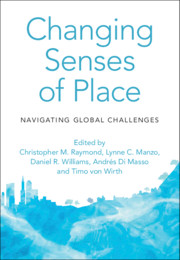Book contents
- Changing Senses of Place
- Changing Senses of Place
- Copyright page
- Dedication
- Contents
- Contributors
- Foreword
- Preface
- Acknowledgements
- Introduction
- Part I Climate Change and Ecological Regime Shifts
- 1 Coral Reef Collapse and Sense of Place in the Great Barrier Reef, Australia
- 2 Navigating the Temporalities of Place in Climate Adaptation
- 3 The Place–Subjectivity Continuum after a Disaster
- 4 Changing Sense of Place and Local Responses to Bengaluru’s Disappearing Lakes
- 5 Place-Making for Regional Conservation
- Part II Migration, Mobility and Belonging
- Part III Renewable Energy Transitions
- Part IV Nationalism and Competing Territorial Claims
- Part V Urban Change
- Part VI Technological and Legal Transformations
- Part VII Design and Planning Strategies for Changing Senses of Place
- Part VIII Conclusion
- Index
- References
2 - Navigating the Temporalities of Place in Climate Adaptation
Case Studies from the USA
from Part I - Climate Change and Ecological Regime Shifts
Published online by Cambridge University Press: 15 July 2021
- Changing Senses of Place
- Changing Senses of Place
- Copyright page
- Dedication
- Contents
- Contributors
- Foreword
- Preface
- Acknowledgements
- Introduction
- Part I Climate Change and Ecological Regime Shifts
- 1 Coral Reef Collapse and Sense of Place in the Great Barrier Reef, Australia
- 2 Navigating the Temporalities of Place in Climate Adaptation
- 3 The Place–Subjectivity Continuum after a Disaster
- 4 Changing Sense of Place and Local Responses to Bengaluru’s Disappearing Lakes
- 5 Place-Making for Regional Conservation
- Part II Migration, Mobility and Belonging
- Part III Renewable Energy Transitions
- Part IV Nationalism and Competing Territorial Claims
- Part V Urban Change
- Part VI Technological and Legal Transformations
- Part VII Design and Planning Strategies for Changing Senses of Place
- Part VIII Conclusion
- Index
- References
Summary
Climate change adaptation demands a deeper appreciation of plural senses of place and how these pluralities can create synergies as well as frictions in adaptation practice. In this chapter we aim to explore one highly overlooked dimension of this global challenge – the plural temporalities embedded within senses of place. Here we explore the dimensions of time in place-focused adaptation efforts by drawing on a series of case studies that utilise scenario-based futures methods. These methods have rapidly become critical tools in tackling the exigencies of the climate crisis but too often they presume a singular temporal mode and marginalise other temporalities and senses of place. This chapter concludes by offering new ways to reconceptualise plural senses of place and time in both theory and practice.
- Type
- Chapter
- Information
- Changing Senses of PlaceNavigating Global Challenges, pp. 32 - 42Publisher: Cambridge University PressPrint publication year: 2021



